A Brief History of Marie Antoinette
Misunderstood, younger sibling with excellent style thrust onto the European stage? Or basic, out of touch royal? [2023 reissue]
This article is from the 21st & 18th archive, originally featured on 22 November 2023. Next week we will return with a feature on Leigh Batnick Plessner, Chief Creative Office of Catbird (@catbirdnyc), a New York City based fine jewelry concept. Subscribe below to receive the feature direct to your inbox.
Marie Antoinette: The Final Queen of France
First there was Maria Antonia
Born Maria Antonia on 2 November 1755 in Vienna, Austria at the Hofburg Palace she was the 15th1 child and youngest daughter of Maria Theresa and Francis I, Holy Roman Emperor. You certainly know her as Marie Antoinette (her Frenchified name), wife to Louis XVI and the final Queen of France who, in the end, lost her head at the Place de la Concorde. While all of this is true, Marie Antoinette, just as every human, was more than her beginning and demise.
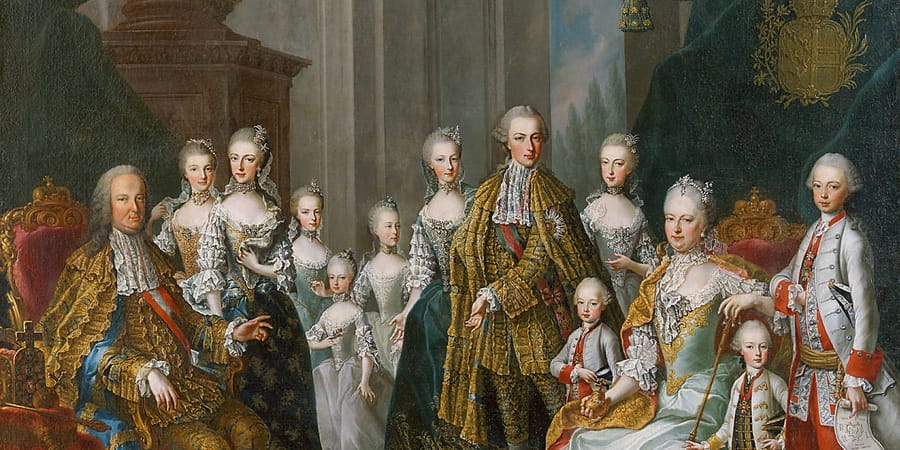
Note: Although she was born Maria Antonia, we will refer to our main character as Marie Antoinette from here onward.
In 1756, one year after Marie Antoinette’s birth, the beginning of the Seven Years’ War2, and a minute after the Diplomatic Revolution3, her mum, Maria Theresa, brokered a deal with Louis XV of France that would ideally unite two European strongholds against the goals and ambitions of Prussia and Great Britain. There was to be a royal wedding - in a decade or so…
The Austrian Archduchess who would eventually become Queen of France was one in a long line of Habsburgs of her generation (child number 15!) and given so was very much a royal afterthought, in terms of her education. MA’s early life was largely one of familial happiness and, given what we know about the Austrian Imperial family and their lifestyle in Vienna in the 1700s, we must assumer life was pretty lush - who wouldn’t want to grow up at Schönbrunn?
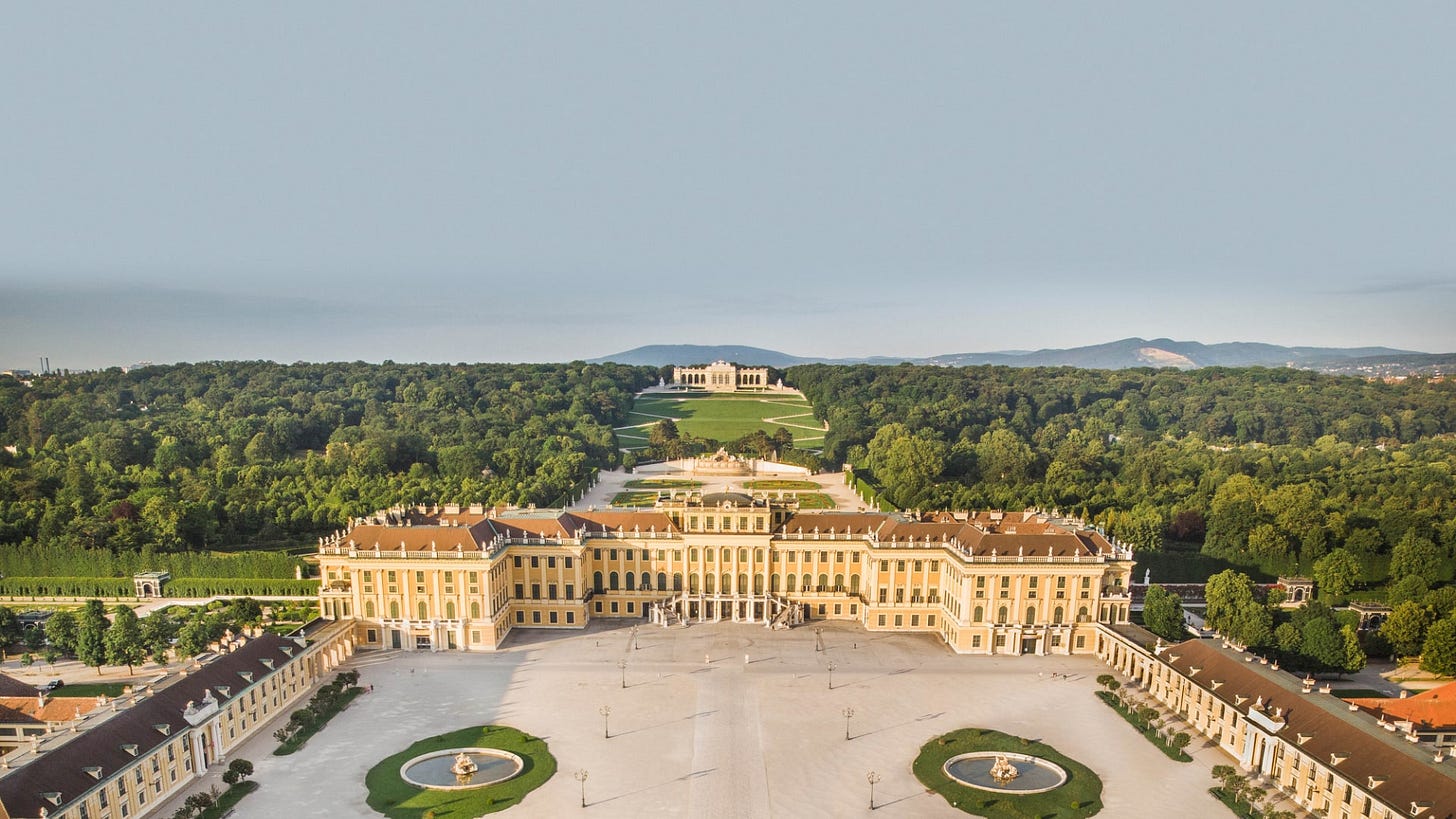
Although her early years were filled with large, colorful family memories, as the youngest daughter and second to youngest child of her family her education fell by the wayside. At age 10 her tutors reported a complete lack of competency in writing and conversing in German or any other language, the singular bright spot in their seemingly hopeless pupil’s skillset? Her gift for and keen appreciation of music - she was also apparently a wonderful, graceful dancer.
Did you know? When she was 7, MA met Wolfgang Amadeus Mozart (yes, just the one you’re thinking) when he came to play for her parents at the palace, she and Mozart were the same age. MA was taught by Christoph Willibald Gluck, a German composer highly revered by Mozart and his contemporaries. While Marie Antoinette and Mozart were destined for very different lives they both, ultimately, met their maker all too early and tragically - causing one to pause and consider what conversation may have transpired during their fateful meeting in Vienna.
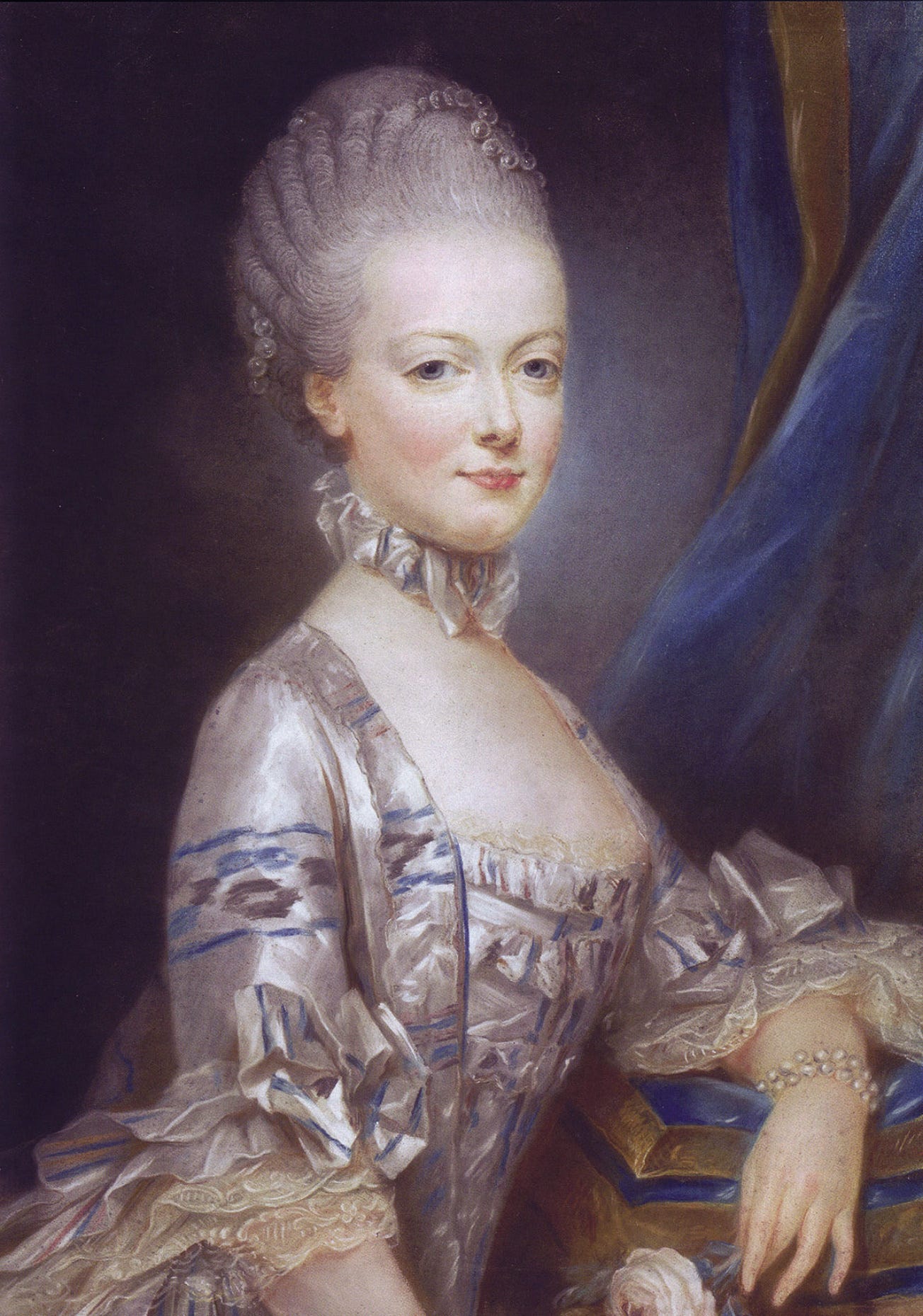
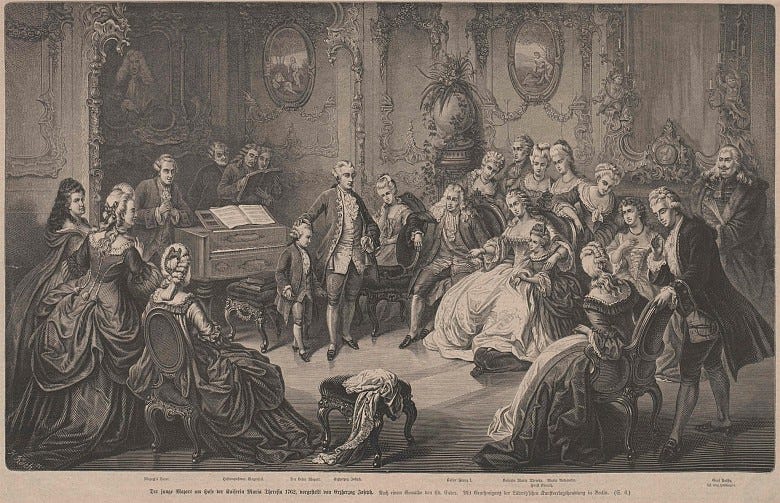
In 1768 at the age of 13, our girl became officially engaged to Louis the Dauphin4 of France. That same year Mathieu-Jacques de Vermond, an official tutor hired by Louis XV, was dispatched from France to Vienna to school the young fiancée - aka both France and Austria were eager to spackle the Queen-to-be’s educational gaps as quickly as possible and, ideally, before she arrived in Versailles.
After a year of lessons, in every subject, language and social grace deemed necessary for her future role as Queen, plus a painful phase of corrective braces5, Marie Antoinette married Louis-Auguste, Dauphin of France at the age of 14 at Versailles (I have a hangover imagine the raucous and sugary reception that followed). Of their early marriage years, we need to note here that MA and Louis didn’t quite, how to I word this, click? TLDR; it took seven years to consummate their marriage.
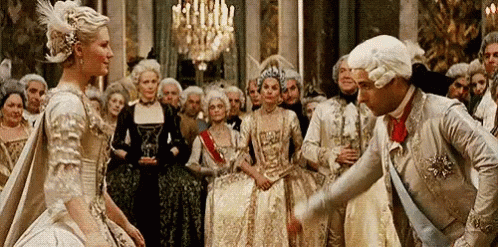
Aside from their marriage bed fengshui being completely in the can, in 1774 Louis ascended the throne as King of France, upon the death of his grandfather, Louis XV, making Marie Antoinette, officially Queen.
With their new titles and as their marriage and relationship matured, MA and Louis brought 4 children into this world, 3 of which survived infancy. Despite delivering on the anxiously awaited heir to the throne of France, Marie and Louis’ growing family and increasingly positive partnership was marred by the shifting economic and social upheaval sweeping through France (and much of Europe and her colonies).
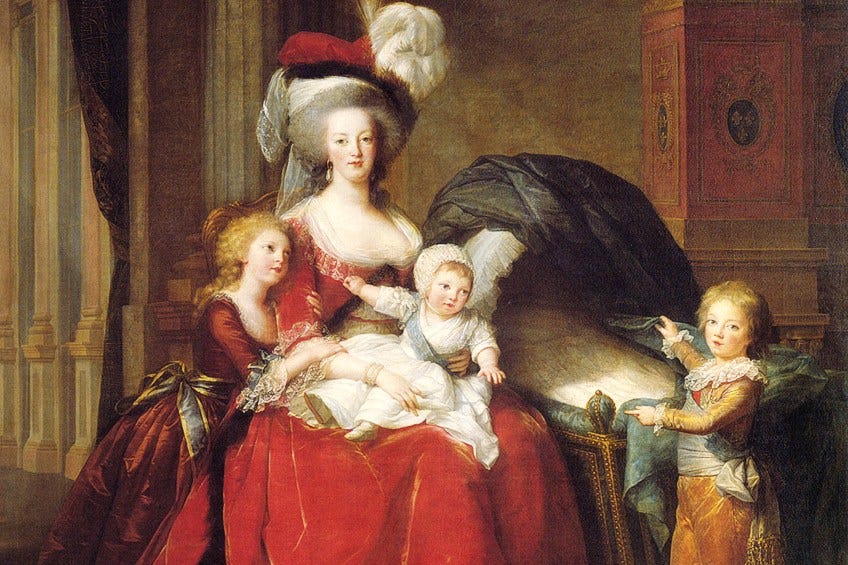
Bringing up Marie
During these difficult, transitional years Marie Antoinette literally grew up. Remember she married Louis when she was only 14 years old - a teenager, who wouldn’t legally be able to drive in the 21st century6. She was growing up, getting married, trying to fit in on the European stage of politics, hoping to get knocked up sans the physical relationship with her husband which getting knocked up required, attempting to jive with her new Austrian-hating-in-laws - all while preening to every and any French citizen in the hope of becoming beloved. Can you imagine the stress? What were you doing between the ages of 14 - 19? Producing the heir to a centuries old dynasty? Trying to please your Empress mother? Let me guess, your teenage bingo card was more likely stocked with, ‘swipe booze from parents’, ‘study for SAT’, ‘get asked to prom’, ‘acquire Ugg boots’ etc.
We have great insight into the world of Marie Antoinette during her early years of marriage and Queen-hood as she often corresponded with her mother, Maria Theresa, who consistently kept tabs on her to ensure Austria’s strategic alliance with France was destined for greener pastures. Sadly, in 1780 Maria Theresa departed this world for the next, anointing Marie Antoinette’s brother, Joseph, to Holy Roman Emperor.
While Marie Antoinette fulfilled her duty bringing forth an heir, life at court and her popularity amongst the aristocrats and people of France suffered. A war in the Americas to assert dominance over Britain, a promotion of her court favorite, the Duchesse de Polignac7, to Governess of her children and a rumored8 affair with Swedish Count Axel von Fersen all, unfortunately, sifter together fatefully to tank Marie Antoinette’s standing in the eyes of the aristocratic class while also drawing her out as a target for political and economic pamphlets and outspoken French citizens seeking social reform. She was the scapegoat, everyone, of all backgrounds, needed.
Diamonds are not a Queen’s Best Friend
The clincher in her waning reputation was the Affair of the Necklace. Aptly named for an awful circumstance, which made Marie truly look a-fool, surrounding a diamond necklace. Namely, one larger than life diamond necklace worth over US$15mm today. In short, a prince of the Church, Cardinal de Rohan9, was tricked into commissioning a jaw dropping-ly lavish diamond necklace for Marie Antoinette, by a known thief called Jeanne de la Motte. Jeanne feigned the impression of the Queen and seduced the Cardinal, borrowing money from him and eventually, asking him to purchase a necklace, on her behalf, fashioned by jewelers Charles Auguste Boehmer and Paul Bassenge. The particular necklace Jeanne was after? The big daddy of diamond commissions, a necklace originally ordered by Louis XV for his mistress, Madame du Barry (because Louis XV has passed away before gifting the necklace to his mistress it sat orphaned and the jewelers in difficult financial straits). Jeanne had her eye on the piece, and through intrigue, disguises and forged letters and signatures she and her comrades duped Cardinal de Rohan into purchasing it, on payment plan, while she posed as Queen Marie Antoinette. In 1785 all events came to a head when jewelers, Boehmer and Bassenge paid a visit to the actual Queen of France to beg for payment of the necklace in full. As you might imagine, Marie Antoinette was displeased and, in a fury, confronted the Cardinal with Louis XVI by her side leading to their order of the Cardinal’s arrest. Following an investigation, the tale broke to the people of France and the Cardinal was stripped of his office and title and exiled to the abbey at La Chaise-Dieu in the South of France (ironically he would be acquitted of all legal charges and wrongdoing in the Affair and end up outliving both Louis XVI and Marie Antoinette).
In the wake of the Affair of the Necklace, things got worse for our girl. Political tensions swam in increased friction as Louis XVI was alienated by advisors and turned, more frequently to his wife for advise, who, despite having useful ideas and making a genuine show of support for the changes being implemented in France’s Finance Council, found it was an uphill battle incapable of winning: A country recovering from frequent expensive and long wars led by a royal family known for their excessive generational spending and with aristocratic and wealthy classes living happily without proper taxation? The state was one of disaster.
As this economic horror continued the Dauphin, eldest son to Marie Antoinette and Louis XVI, fell ill from, and would eventually die of, tuberculosis an event that, given the social (ie. historic bread shortage) and economic strife budding in every corner of France, went almost unnoticed by the people (poor lil Dauphin).
In 1789 the Bastille was stormed and Versailles imploded as the revolutionary Third Estate declared itself France’s National Assembly and a new government began to wade through Paris. From this year onward, Marie Antoinette and her family underwent a slow, painful, demise until October 1793 and her inevitable execution by guillotining - reading back through the details of these almost four years her execution was written on the wall, impossible to outrun, properly inevitable.
The Queen’s Final Four Years
Most people think Marie Antoinette shopped, designed clothes and wore skyscraper wigs while drinking champagne. Some of this is true, because after all she lived in France during the 18th century and had almost resources, however most of her life was spent preparing to be a wife and mother and understanding how to support her husband, the future King of France. Anything outside of these roles, was extracurricular.
The thing about Marie Antoinette is that she was never trained to be the strategic leader, diplomat and humanist other European queens or female leaders may have. Her mother Maria Theresa was an outstanding and exceptional leader who defied gender norms and legalities of the early 1700s, but she pushed the limits of what she was trained and brought up to do - Maria Theresa re-wrote her job description. On the other hand, Marie Antoinette accepted her role as wife and heir-producing-Queen, as many royal or aristocratic women did in the 18th century, she did not need to do more because she fulfilled all that was asked of her, and when she began attempting to do so, it was simply too late to make a difference.
If we consider her role as wife and mother: Is it nothing to have brought 4 children into this world and secured the legacy of the House of the Bourbons? Is it nothing to have been married at age 14, had a difficult time finding common ground with your husband but, nonetheless, have made it work because the good of the realm, literally, depended on it?
During her 16 year marriage to Louis XVI Marie Antoinette was a critical supporter of the King, providing him confidence, a family escape and in the last decade of his life, political and social advise. She was always there for Louis XVI, which is impressive given the highest highs and lowest of lows they experienced together.
In terms of Marie Antoinette’s achievements, I urge you to dig mainly into what she achieved during the beginning of the Revolution, in the years before her execution. When their royal bubble burst, officially in 1789, she did not lay down and crumble, rather she stood beside her husband and fought, making alliances, appointing new political leaders, adapting their lifestyle and marketing her commitment to motherhood and family - but it was all in vain. None of it mattered, regardless of how good or fair she tried to be, Marie Antoinette was always going to face Madame la Guillotine.
Looking Beyond History’s Headlines
Contrary to general belief, there is no proof Marie Antoinette uttered the phrase, “Let them eat cake” when referring to her starving French subjects’ continued pleas for bread and sustenance.
Before you posit that Marie Antoinette should have had a more strategic publicist, we have to consider her in context and as a human. We know, from centuries of records, letters and depictions of royal women, particularly in Europe, they were raised for one role, to marry, produce heirs and depict the ideal of a pious, loyal and serene wife and woman. In most cases, once royal women produced children, mostly importantly male heirs, they sort of got a free pass to sit back and relax.
It is interesting to consider the legacy historical figures and celebrities leave behind. I recently watched the latest episodes of Netflix’s The Crown, which overviews the final weeks of Princess Diana of Wales’ life. It is very well done, dramatic and almost feels like an account of reality. However the fact remains that we are watching a dramatized assumption, informed by fact, of her last weeks walking this Earth. At the end of the day we don’t know what happened, even in the life of a highly photographed contemporary celebrity or public figure - unless we knew them. In the case of historical figures, we have less fact and documentation to go on which means we all begin projecting our thoughts, wants and imaginings on these figures, admittedly, it’s difficult not to do so. When studying historical figures, we need to consider them in context, as best as we can, and in my experience studying history, the most interesting findings and realizations about humanity and society are always had when learning about what was happening around a historical figure to try and understand why/where/how they came to be them. In this case, we need to dig out Marie Antoinette’s world, why she was in France, how she came to be the Queen of France, how she was raised, when she was raised, what was happening politically and economically before, during and after her life. All of this lends critical color to the study of 18th century celebs.
Final Thoughts
Marie Antoinette’s story is extremely complex, with a variety of dimensions we cannot cover in this Brief History. What I hope you glean from this read is, an understanding that we will never fully know what transpired in the past but the realization that we can empathize with the plight of humans who came before us. We, as humans, can relate to making irrational decisions in the wake of anger or suffering, taking the easier road when there appears to be no negative ramifications to such and blaming the bad on someone or something to help us sleep more soundly at night. In the end, we can all relate to this: Humans want something to believe in, something or someone to ease the pain of the human experience.
Thoughts on Marie Antoinette? Write to me at lauren@21stand18th.com.
21st & 18th Recommends
Read: Abundance: A Novel of Marie Antoinette by Sena Jeter Naslund
An intriguing format combining Marie Antoinette’s letters, fact and a sprinkling of fiction magic, this is a great novel for thinking about Marie Antoinette’s day to day and considering how she may have felt marrying the prince of her native land’s fiercest enemy - at just 14. Naslund’s novel plates themes many of us can relate to today: self consciousness, pleasing your controlling and high achieving parent, the struggle of partnership both courtly and friendly and the belief that your actions are in the effort of a higher power or being.
Visit: Library of Congress
For excellent resources on Marie Antoinette, the French Revolution and its key players. I recommend taking advantage of the digital catalog at the Library of Congress, it’s free and boasts well cited source material for reading and research - just the place to get your history kicks.
Watch: Marie Antoinette, PBS, Television series
Watch with the understanding that this show is meant to be entertaining, it is not the arbiter of absolute truth. It is very engaging - beware it portrays a very immature side to MA. Costumes are excellent, however.
Watch: Marie Antoinette, Film by Sofia Coppola, 2006
Have you seen this masterpiece by Sofia Coppola? It’s completely visually seductive - TLC for your creative soul. Also the soundtrack is a perfect combination of moody, misunderstood and feminine. I will always adore this film and use the still image of Rose Byrne biting into dessert as my Macbook screensaver.
Marie Antoinette’s story is extremely complex, with a variety of dimensions that we are not going to fully cover on Thanksgiving Eve. What I hope you glean from this read is, an understanding that we will never fully know what transpired in the past but the realization that we can empathize with the plight of humans that came before us. We, as humans, can relate to making irrational decisions in the wake of anger or suffering, taking the easier road when there appears to be no negative ramifications to such and blaming the bad on someone or something to help us sleep more soundly at night. In the end, we can mostly relate to the fact that humans are all just looking for something to believe in, something or someone to ease the pain of the human experience.
15 of 16 children - absolutely nuts (!)
A war that involved most all powers of Europe, in which Britain and England were vying for supreme dominance while Prussia battled to establish itself as the preeminent power of Europe, the skirmish lasted from 1756 - 1763, was fought in a variety of countries and continents and catalyzed a handful of smaller wars and political events
Dictating the moment, between the War of Austrian Succession and Seven Years’ War when Austria flipped from Britain’s ally to that of France - critical in our story and understanding of Marie Antoinette
Literally translates to dolphin, interesting parallel, this was the official title given to the prince of France who was heir to the throne. After marrying Louis, Marie Antoinette became the Dauphine of France
I cringe to think of what braces in the 1700s were like
Cue Clueless quote here ; )
Yolande de Polastron, formally the Duchesse du Polignac, was a close friend and confidante of Marie Antoinette who hailed from an old family of tenuous standing within the aristocratic sect. She was an instant favorite of Marie Antoinette’s and gained an incredible number of enemies at court at Versailles due to her closeness with the Queen and the financial and social priority she experienced.
The key word is rumored, there is no proof of this affair, though it is highly discussed and depicted in pop culture
The best part was the Cardinal was truly detested by the Queen, Marie Antoinette would not entertain him or receive him due to salacious rumors he perpetuated in France and to Marie Antoinette’s mother, Maria Theresa







